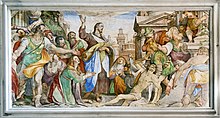Federico Zuccaro
Federico Zuccaro (Sant Angelo in Vado, 1542 - Ancona, 1609) was an Italian painter, architect and writer, who worked in Spain.
He was a student of his brother Taddeo Zuccaro, whom he helped in his work in the Vatican and the Palazzo Caprarola. The Duke of Tuscany Cosimo I then called him to his court in Florence to finish there the decoration of the dome of Santa Maria del Fiore, begun by Giorgio Vasari.
At the request of Pope Gregory XIII, he began to paint the Pauline Chapel in the Vatican Apostolic Palace, but for personal reasons he had to flee to London in 1574. He spent six years at the English court, painting mostly portraits. The best-known paintings from this period are the portraits of Queens Elizabeth I and Mary Stuart.
In 1580 he moved to Venice, painting a Humiliation of Barbarossa for the Doge's Palace. Pope Gregory XIII encouraged Zuccaro to return to Rome to finish the Pauline Chapel, and he did so. In 1586 he followed the call of King Philip II to move to Madrid and collaborate in the decoration of El Escorial. He mainly dedicated himself to painting altarpieces and frescoes.
He returned to Rome, where he founded the Accademia di San Luca, of which he was the first president.
In addition to his pictorial activity, Zuccaro also worked in the field of art theory.
Works
- Frescos in the Villa d'Este, Tivoli, in collaboration with Taddeo Zuccari;
- The Conquest of TunisiaFresco in the Regia Hall of the Apostolic Palace, Vatican City;
- Paintings at the Pauline Chapel, Apostolic Palace, Vatican City;
- The Fall of SatanFrescos in the Pius V Chapel of the Apostolic Palace, Vatican City;
- Wizard worship, 1564, in the church of San Francesco della Vigna, Venice;
- Paintings of the main altarpiece of the monastery of San Lorenzo de El Escorial (in collaboration with Pellegrino Tibaldi);
- The expulsion of the temple, 1571, altarpiece in Santa Caterina dei Funari, Rome;
- The veneration of the Dogo before Pope Alexander III in the Atrium of Saint Mark of Venice;
- The humiliation of Barbarosja before the Pope, about 1582, Sala del maggior consiglio, Palacio de los Dogos, Venice;
- Cycle of frescoes on the life of San Carlos Borromeoin collaboration with Cesare Nebbia, 1604, Almo Collegio Borromeo, Pavia;
Writings
Contenido relacionado
Ferdinand I de' Medici
Manuel Tolsa
Mosque-Cathedral of Córdoba
Alhambra
Hospital of the Holy Cross and Saint Paul
